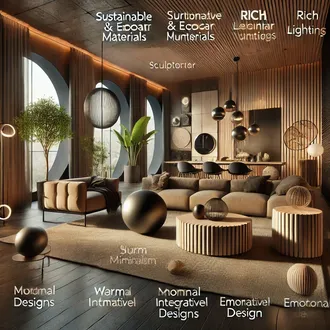Transcription Choosing the curtains
The main function of curtains is still in many cases to regulate the passage of light and air into rooms, protecting them from intense sunlight and drafts that are too cold or too warm. However, due to the important role that curtains play in the decorative ambience of interior spaces, their aesthetic functions are increasingly taken into account.
There are infinite varieties of curtains on the market in terms of types, materials, designs and accessories, so it is necessary to know their characteristics, to select the one that best suits the peculiarities of the room, the typicality of the windows or translucent walls and the decorative atmosphere we want to achieve.
Types of curtains
Curtains are classified according to the material with which they are made in fabric, metal, wood, etc.; according to the operating mechanism in manual, mechanical and automatic; and according to their functional quality in thermal, acoustic and blackout.
The types of curtains most commonly used in interior spaces are as follows:
- The traditional curtain: These have been used in homes for the longest time and are still the most widely recognized and used in homes. It consists of a fixed rod of wood or other material to which a fabric is hung. Its main advantages are.
The different fabrics provide an infinite variety of colors, shapes, textures and light to the spaces, considerably enriching the decorative environment:
- They can be easily installed, cleaned and replaced.
- They can be adapted to any space and pocket.
The sheers: They are a type of curtain that has been traditionally used to filter the intense rays of sunlight so that a less intense and relatively uniform light reaches the interior. They are made of lighter and more transparent fabrics than curtains and, like curtains, play an important decorative role. Sheers and curtains can be easily combined in a window or a translucent wall to modify the temperature, the amount of light and the aesthetics of the space. Blinds: They are a type of curtain that unfolds vertically, taking up less space than traditional curtains, so they are very appropriate for small spaces. By the way they unfold you can find roller blinds and folding blinds, both types are highly resistant and easy to handle and maintain. They can be made of different materials, which means that some allow the passage of almost all sunlight, while others block it partially or completely.
Blinds can also be combined with curtains or sheers on a window or a translucent wall to modify the temperature, the amount of light and the aesthetics of the space. When selecting the blind for a window you should make sure that it measures about 20 centimeters wider than the window; this way you can leave at least 10 centimeters on each side to prevent the sun's rays from entering when they are positioned diagonally to the window.
Venetian blinds: These are a type of curtain or blind made of thin slats of aluminum, PVC or wood, which are regulated by cords or other mechanisms, in order to moderate the entry of light into the spaces. They are usually found in neutral and plain colors, however, the wooden ones give a natural, rustic and warm touch to the spaces.
Japanese panels: They are formed by panels placed vertically and overlapping each other attached to an upper rail and with a counterweight at the bottom to keep the panel straight. This type of curtains is ideal for large windows or glass walls, as they can be extended over large spaces. It has some other advantages such as: they are easy to assemble and wash, open in different directions and provide many options for the management of aesthetic elements as they are manufactured in a variety of colors and patterns, they can even incorporate digital prints to taste, such as the image of a landscape or a favorite pet.
Elements to take into account when selecting the curtains for a room
Determine what will be its main function: To know what is the first requirement to be taken into account when selecting a curtain we must always start from knowing why I need it? For example: I need a curtain so that the sun's rays do not dazzle the baby in the early hours of the day. In this case, the first thing to do is to
materials curtains




